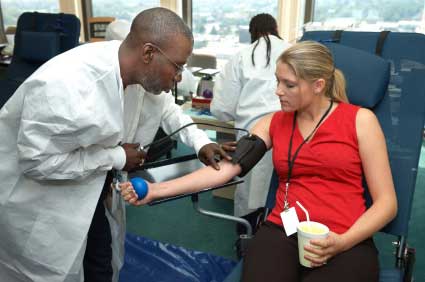Introduction
What is HIV?
Let's start with the basics. HIV stands for Human Immunodeficiency Virus. According to the Centers for Disease Control and Prevention (CDC), nearly 20,000 individuals with AIDS die in the United States every year. And nearly 57,000 more Americans are infected with HIV virus each year.
The HIV virus cannot replicate on its own, but needs to invade and infect other cells in the body on order to replicate. HIV is considered a retrovirus, or one that is slow acting that can take years between infection and onset of symptoms to develop.
HIV infections enter the body through the bloodstream, mucous membranes, or by contact with infected blood or other bodily fluids. Following infection, certain cells, called CD4+T cells, rapidly reproduce and replicate.
Think of CD4+T cells as the front-line soldiers of the immune system, the body's major defense against infection. In a healthy adult, the CD4+T cell count typically ranges above 1,000. Over time, the HIV virus gradually reduces this number. At the point where an individual has fewer than 200 of these T4 cells, the body is no longer able to protect and fight against what are known as opportunistic infections.
Following exposure to the HIV virus, the immune system's ability to properly function is disrupted. The HIV virus attacks the body's immune responses, literally disabling them, giving the virus the chance to replicate, as well as to attack and kill the body's own immune response to the virus.
Gradually, the body's immune system is destroyed to the point it is unable to protect the body against other illnesses, such as a cold, pneumonia, infections, cancers, or organ damage. Eventually, a person may enter the stage known as AIDS, or Acquired Immunodeficiency Syndrome.
What Is the Difference Between HIV and AIDS?
At its most basic definition, HIV is a virus that eventually causes AIDS. Human immunodeficiency virus merely means that a virus or infection has invaded the body, disrupting the immune system's ability to function properly. Between infection and onset of symptoms, a person may enjoy a perfectly normal and active lifestyle and activity levels, being none the wiser that a virus has invaded the body.
AIDS is not an inherited condition, but must be acquired, hence its name. The term "syndrome" implies that a number of conditions or symptoms may be present during this stage of the disease, most typically caused by failure of the immune system to function properly.
Not all people diagnosed with HIV infections have AIDS. HIV may or may not progress in stages, ending up with the AIDS diagnosis. Individuals who live with HIV infections, who don't typically experience symptoms, are called asymptomatic, meaning without symptoms. Following early symptoms of the condition, most individuals are diagnosed with early symptomatic HIV. As the condition worsens and damages the immune system, a person may be diagnosed with opportunistic infections, such as pneumonia, tumors, chronic coughs, and lung damage and organ failure.
Each individual may react to the HIV virus in a different way. For example, basketball player Earvin "Magic" Johnson was diagnosed with AIDS nearly 20 years ago. He continues to lead a fairly active and normal healthy lifestyle, even though at the time of his diagnosis, many people feared that he'd been delivered a death sentence. Because he was diagnosed as such an early stage, and continues with his drug treatments, Magic's prognosis is fairly good. Actually, many individuals today who experience both effective drug treatment coupled with early detection have a roughly 90 percent chance of holding the HIV virus in check without ever developing AIDS-related conditions or infections.
HIV and AIDS testing methodologies, education and awareness programs, as well as new drug treatments given at this stage of the disease have helped thousands of individuals lead a normal lifestyle.
A person living with HIV needs to take certain precautions; but just because a person is diagnosed as HIV positive, doesn't mean the person will develop AIDS.
The next stage of the HIV virus is called seroconversion. During this time, the body's immune system produces antibodies against the HIV virus in an effort to protect itself. Common symptoms at this point may include swollen lymph nodes and flu-like symptoms. During this period, the virus is highly infectious.
Following the period of seroconversion, a person may experience what is known as an asymptomatic period. No symptoms are felt or experienced during this period. For some people, this period may last six months, while for others 10 years or more may pass symptom-free. It's impossible to determine exactly how long it takes one person or another to experience symptoms. Even if the person is not showing any symptoms, and may feel perfectly healthy and strong, the virus continues to replicate and reproduce inside the body. The replication of the virus will cause a general, gradual, and inevitable weakening and decline of the body's immune system.
Conclusion
The effects HIV may have on the body include both physical and mental changes, some of which are slower to appear than others. Again, every individual may react to the HIV virus differently, and just because one person experiences certain symptoms doesn't mean that another will experience the same.
How Does HIV Affect the Body?
Introduction
HIV affects not only the physical ability and overall health of the body, it may bring some emotional and mental impacts and challenges as well. Of course, different individuals will react to the disease process in various ways, depending on their character, personality, symptoms, and overall prognosis.
Understanding the basic effect that HIV has on the physical, emotional, and mental well-being and development of any individual will help prepare them for changes, now and in the future. Adapting lifestyle and behaviors may also properly and effectively reduce frequency and severity of symptoms and complications by understanding the HIV process following diagnosis.
Physical Effects of HIV on the Body
Because the HIV infection is a virus, your body, depending on your current health, weight, physical activity, and overall function of your immune system, may not experience the same effects as someone else.
According to the Arizona State University, HIV is one of the most powerful viruses, with a faster mutation profile than any other. The HIV virus is a type of retrovirus called an RNA virus. RNA stands forribonucleic acid. RNA is required for basic cellular structure and life. There are several different forms of RNA, including:
mRNA - called "messenger" RNA
tRNA - known as "carrier" RNA
rRNA - also called ribosomal RNA
Each form of RNA is vital to cellular function and design, and has a basic job or functions -- such as binding protein cells together, creating cellular energy, carrying and binding amino acids, and so forth. We won't get into an in-depth scientific explanation of the purposes of RNA , but it's important to understand that some viruses, such as HIV, attack RNA genetic codes and use "messenger" RNA, or mRNA, to transport the HIV virus to all areas of the body.
In order to replicate, such viruses bind to specially encoded proteins that are found on the surface of your cells. Such proteins act like receptacles, or doorways. When a component of the HIV virus finds and attaches itself to such a receptacle, or doorway, it has an entry point into the internal structure of the gene.
Using a very simple explanation regarding how HIV proliferates in the body, once the door is opened, the virus is then able to replicate or duplicate its components as the cell continues to multiply, regardless of how quickly the door is closed again. In this way, the HIV virus spreads to multiple body organ systems, much like an uninvited guest raiding your refrigerator.
The HIV virus affects the body in different ways, depending on the phase of the disease. For example, we already explained that HIV directly affects the function and ability of the body's immune system to operate at optimal levels. One of the most important types of cells found in the immune system is called a T-cell. Think of T-cells as soldiers that protect the fort (you) from attack, virus or infection, bacteria, or diseases.
If the soldiers, or T cells, are damaged or otherwise hindered from doing their job, they fail to provide an adequate response to such invasions. The HIV virus is further broken down into a number of phases, which include:
M-trophic phase - During this phase, the HIV virus burrows into the immune system's cellular structure and initiates replication.
T-trophic phase - At this point, the virus has mutated and focused on destruction of T cells, which, after time, ultimately destroys the ability of the immune system to fight off even the simplest cold.
Dual-trophic phase - This phase describes a combination of the M- and T-trophic phases. At this point, the HIV virus not only burrows into immune system's cellular structures, but also infects the T cells and special cells found in the immune system that surround, destroy, and ingest invasions of bacteria and other cellular debris. These garbage disposal-like cells are called macrophages.
For most individuals, it can take anywhere from two weeks to six months or more to create and develop antibodies to fight against the HIV virus. Just because antibodies are being developed doesn't mean that they will be successful. To date, there is no cure or known reversal of the HIV virus. The main indication is the presence of antibodies for HIV found in a blood test.
A majority of individuals infected with HIV virus don't even know they're infected until they obtain a blood test or a verbal diagnosis from a health care provider. They often lead healthy, active, and normal lives and engage in everyday activities. Other individuals may develop some symptoms, such as a general feeling of fatigue, or cold or flu-like symptoms.
Mental and Emotional Effects
The mental and emotional effects of an HIV diagnosis can be just as devastating as physical symptoms. Despite education, resources, medications, and understanding of HIV and AIDS, the diagnosis still carries with it a large stigma. People are still afraid of being infected by a hug, a handshake, or even sharing a toilet seat. Ostracism and avoidance are still major issues that individuals diagnosed with HIV must deal with, and the constant need to educate and inform others regarding their disease can be a constant drain on the emotions.
An HIV diagnosis, for both the individual diagnosed with the condition, as well as friends, family members, and partners, may provoke a number of feelings -- including concern, sympathy, anger, and blame.
Depending on interpersonal relationships, and the understanding and acceptance of peers at home, school, or work, a person's ability to cope and deal with the stress and worry that comes with an HIV diagnosis varies.
Not only does the HIV virus affect the person diagnosed, but family members and loved ones who must watch and worry regarding every symptom, every cold, and cough. Caregivers may also become emotionally and physically drained when dealing with an HIV diagnosis. Some are able to physically and emotionally care for their loved ones, while others are not so equipped, either physically or emotionally.
Caregivers, loved ones and close family and friends of those infected with the HIV virus may go through periods of depression, impatience, hostility, and anger. At the other end of the spectrum, a caregiver may be so involved in the life and care of a person with HIV -- especially those who progress to AIDS -- that the person may literally feel suffocated by the attention and focus placed on the disease itself, and not on him or her as a person.
It's important to remember that many individuals, thanks to early diagnosis and medications, may lead perfectly normal lives even though they have been diagnosed with HIV. While it is important to be educated and knowledgeable regarding the disease, how it's spread, and how to protect family and loved ones from transmission, it's also important to treat individuals diagnosed with the condition as normally as possible.
Conclusion
Individuals diagnosed with HIV gradually become educated and knowledgeable about their condition. They don't need to be reminded on a daily basis that they're sick, or that they shouldn't do this or that. The important thing for both individuals diagnosed with the disease, as well as their caregivers, family, and loved ones, is to encourage as much enjoyment out of life and quality of life as possible.






























